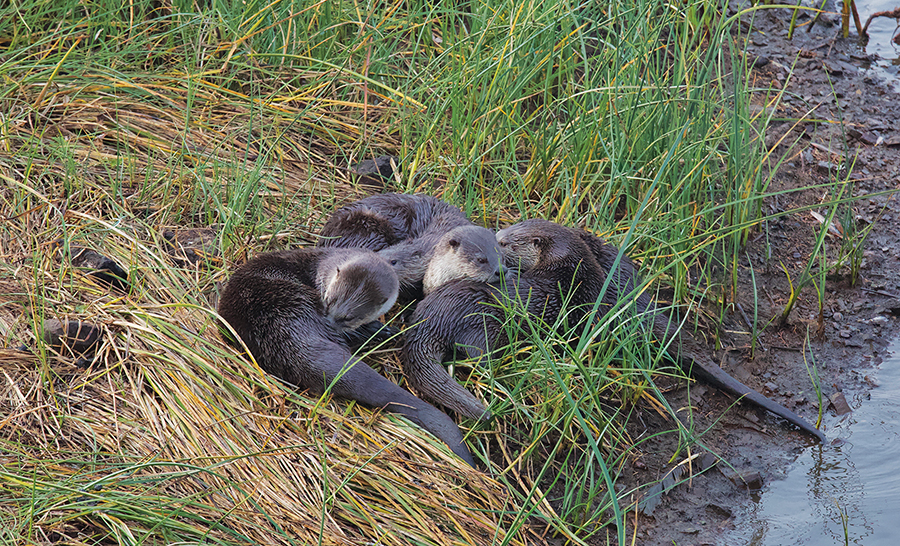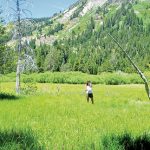
A group of otters on the shore of Rodeo Lagoon in the Marin Headlands. Photo by Karen James.
On an overcast May morning, Karen James crouched on the edge of Rodeo Lagoon in the Marin Headlands. The sun was barely up, and the only sounds were birdsong and the distant crash of waves. The soft gray sky set off the green of the willows, rushes, and ferns around James. A wren, typically shy yet undisturbed by her presence, hopped nearby.
James was there to install a motion-activated camera to record wildlife passing by around the clock. She cares about all the animals that live here but, as part of the River Otter Ecology Project field crew, is most interested in tracking river otters. Strapping the camera to a sturdy branch, she explained that the droppings they leave behind — called scat — show that the otters frequent this sheltered site.
As if on cue, a river otter swam straight for the spot where James was hidden among the leaves. Only its sleek head was visible above the dark water and just before reaching her, it dove. “We’re lucky to see an otter,” she said. “Most of them are denning right now.”
Not long ago, luck wouldn’t have been enough to see a river otter in the Bay Area. Trapping for their luxuriant pelts drove the species close to extinction in California more than a century ago. After hunting them was banned in 1961, the otters began returning to parts of the state. Their recovery in the Bay Area is relatively recent, however, and as of last year the state range map for river otters still depicted the region as an unoccupied expanse.
This spring, the California Department of Fish and Wildlife released an updated map showing where river otters live in the Bay Area. The new map incorporates sightings from the Marin-based River Otter Ecology Project (ROEP). The otters’ expansion here reflects the headway we’ve made in cleaning up waterways and restoring wetlands.
River otters are big eaters, and the fish, crayfish, and other prey they depend on need unpolluted water to thrive. “If there’s enough food for river otters, there’s a healthy environment too,” said Sarah Allen, science program lead for the National Park Service Pacific West Region who is also on the ROEP advisory board. Another factor in the otters’ recovery is restoration of their aquatic habitats, from freshwater streams and ponds to brackish lagoons and estuaries.
Allen enjoys river otters for their own sake too. “They’re fun to watch because they’re never still for long — they’re in constant motion in the water and gallop on the land.” While sea otters frequent brackish waters too, they do not live in fresh water and rarely come ashore. Over the last 30 years, Allen has seen river otters spread through Sonoma County to Tomales Bay and beyond.
“River otters are reintroducing themselves,” she said. “It’s amazing to see how they’re filling up their habitat.” But no one had officially surveyed river otters in the Bay Area for decades.
In 2012, Megan Isadore co-founded the nonprofit ROEP in part to do just that. While working on Coho salmon in Lagunitas Creek, she noticed increasing numbers of river otters there. Isadore was curious to know more about them “but there was very little information,” she recalled. “Fish and Wildlife didn’t even have them as living in Marin.” So she decided to find out more herself.
ROEP’s initiatives include Otter Spotter, a citizen science program for reporting river otter sightings in the Bay Area. Altogether, Otter Spotter sightings added about 4,100 square miles of Bay Area habitat to the 2019 river otter range map, said Melanie Gogol-Prokurat, a California Department of Fish and Wildlife ecologist who analyzes conservation data.
River otters have been spotted throughout the North Bay — Marin, Sonoma, Napa, and Solano counties — and in most of Contra Costa County, the western half of Alameda County, and perhaps one fifth of Santa Clara County. Their range also includes baylands in San Mateo County and San Francisco, as well as the San Francisco Bay itself. While Isadore welcomes all river otter sightings, she is particularly interested in documenting their expansion in the South Bay.
The Otter Spotter program also monitors deaths. “Most dead river otters are hit by cars,” Isadore said. “So many of our roads are along waterways that otters have to cross them.”
Keeping wildlife maps current is important because they inform land use planning. “The maps can help planners know which lands to conserve for habitat and connectivity,” Gogol-Prokurat said. She also cares about the Bay Area comeback of river otters on a personal level. “I grew up in Marin County so it’s really exciting,” she said.
Back at Rodeo Lagoon, once the camera was in place, James checked a small beach in a roped-off protected area on the ocean side of the lagoon. Mother otters bring their pups here to romp in the summer. The beach was empty, but signs of otters were everywhere. “They were just here,” James said. The sand held the story.
Fresh scat and moist spots in the otherwise dry sand told her otters were there recently. Paw prints and other marks covered nearly every square inch of the beach, revealing that the otters ran in and out of the water, and rolled around in the sand. “This is a tail drag,” James said, pointing to a long, thin line in the sand leading down to the water. “These are wallows,” she added, pointing up the beach to large depressions in the sand.
River otters can be easy to miss. “There are river otters here?” said a passing runner. “I’ve been coming for 20 years and had no idea.” It helps if you’re patient and know where to look. At Rodeo Lagoon, James recommends the foot bridge that crosses to the ocean.
“We have this whole hidden world around us,” she said. “There’s lots of wildlife — just because you don’t see it doesn’t mean it’s not here.”
Robin Meadows covers water for the Monitor. She lives near the Suisun Marsh in Solano County, and has seen river otters running down her street and swimming in her backyard pond.

